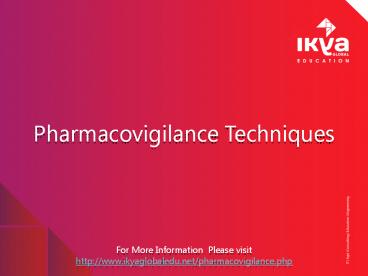Pharmacovigilance Techniques - Ikya Global Education - PowerPoint PPT Presentation
Title:
Pharmacovigilance Techniques - Ikya Global Education
Description:
Pharmacovigilance, for the most part, employs study designs and techniques that are commonly used in epidemiology. This is because pharmacovigilance is primarily associated with detecting and responding to adverse drug reactions (ADRs), which can be studied only through studies such as case-control studies that rely on epidemiological techniques. Pharmacovigilance training thus teaches epidemiological study designs and techniques described as follows: – PowerPoint PPT presentation
Number of Views:132
Title: Pharmacovigilance Techniques - Ikya Global Education
1
Pharmacovigilance Techniques
For More Information Please visit
http//www.ikyaglobaledu.net/pharmacovigilance.ph
p
2
Introduction
Pharmacovigilance, for the most part, employs
study designs and techniques that are commonly
used in epidemiology. This is because
pharmacovigilance is primarily associated with
detecting and responding to adverse drug
reactions (ADRs), which can be studied only
through studies such as case-control studies that
rely on epidemiological techniques.
Pharmacovigilance training thus teaches
epidemiological study designs and techniques
described as follows
http//www.ikyaglobaledu.net/pharmacovigilance.php
3
Case-Control Studies
- These are retrospective studies in
pharmacovigilance in which a group of patients
with a specific disease are compared with another
group without that disease. Patient histories of
previous exposure to identified risk factors are
then compared. This technique, as will be clear
after pharmacovigilance training, is easy, cheap
and fast for collection of data, can help study
uncommon diseases and multiple drug exposures.
However, it may suffer from recall bias and some
information could be missed out.
http//www.ikyaglobaledu.net/pharmacovigilance.php
4
Case Reports
- Pharmacovigilance courses train students in
creating and studying case reports and series.
Case reports are records of single patients who
are administered with a drug. Any observations
including adverse drug reactions are noted.
Records of a group of patients with the same
outcome are known as case series. Case reports
and series are helpful in generating drug safety
signals but cannot determine whether an adverse
outcome was the result of the tested drug. The
incidence of ADRs also cannot be quantified.
Therefore, these are followed up with more
rigorous studies to confirm their findings.
http//www.ikyaglobaledu.net/pharmacovigilance.php
5
Cohort Studies
- This pharmacovigilance technique compares the
results of drug exposure, especially with respect
to ADRs,in a group of people with that of another
group that has not been exposed to the same drug.
These could be either retrospective or
prospective studies. Pharmacovigilance training
incorporates these studies because they enable
the calculation of precise risks and incidence
rates, offer unbiased data for drug exposure, are
applicable to the analysis of multiple outcomes,
and have a relatively low selection bias.
However, they are slightly more expensive, could
yield biased outcome data and may be difficult to
conduct because of the need for a large number of
subjects.
http//www.ikyaglobaledu.net/pharmacovigilance.php
6
Meta-Analysis
- Another technique that students will come across
in pharmacovigilance training is meta-analysis.
This is a very important part of
pharmacovigilance study which helps in the
systematic review of data obtained from clinical
trials. Meta-analytical studies enhance the
statistical power of comparing two different
treatments. However, the detection of rare ADRs
is difficult.
http//www.ikyaglobaledu.net/pharmacovigilance.php
7
Secular Trend Analysis
- This method analyses trends in exposure to drug
which is presumed to have caused an adverse
reaction. This method often utilizes mortality
rates and other such vital statistics. It is
helpful in proving or disproving a hypothesis.
The results are however prone to
misinterpretation, which is one of its drawbacks.
Pharmacovigilance courses train students in
epidemiological research techniques that are
applied for the detection of ADRs.
Pharmacovigilance officers gain insights into the
benefits and ADRs of marketed drugs in the
general public, which helps them take necessary
steps in light of emergencies.
http//www.ikyaglobaledu.net/pharmacovigilance.php
8
Ikya Global is one of the few best
pharmacovigilance training institutes in
Hyderabad that offer training at affordable
prices along with placement assistance and
certification.
For More Information Please visit
http//www.ikyaglobaledu.net/pharmacovigilance.ph
p
9
For More Information Please visit
http//www.ikyaglobaledu.net































